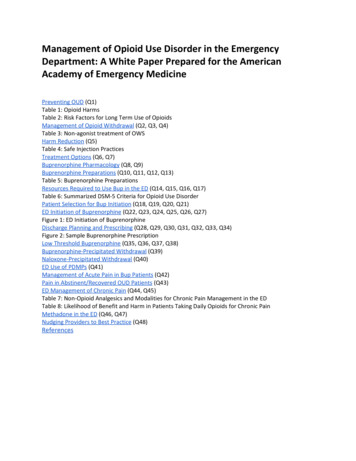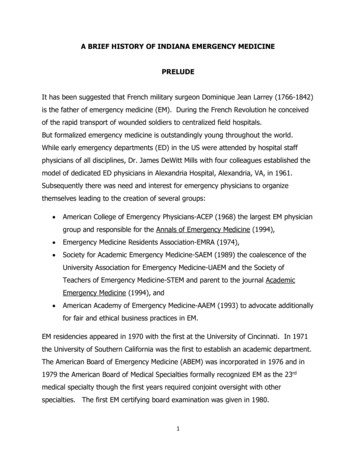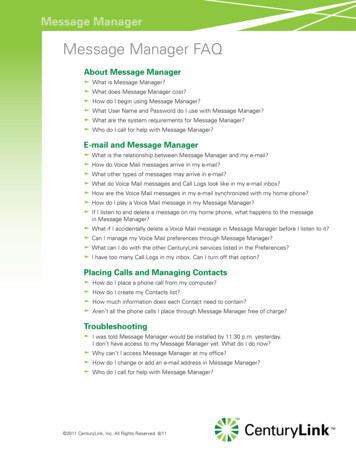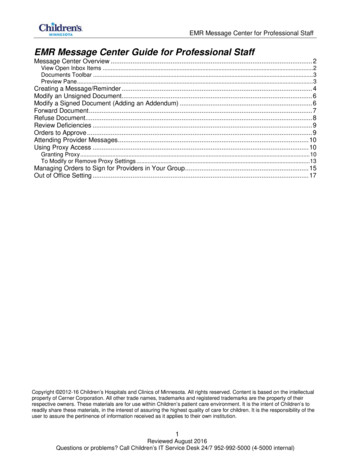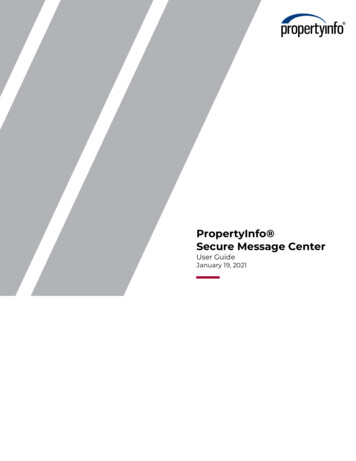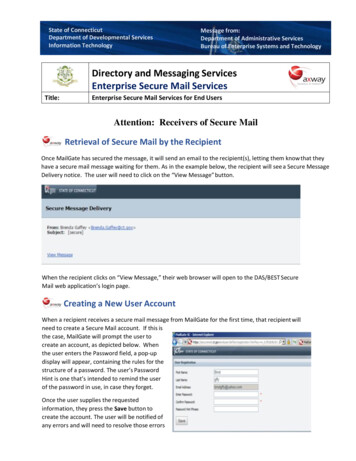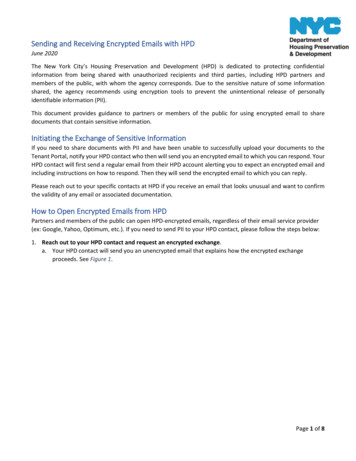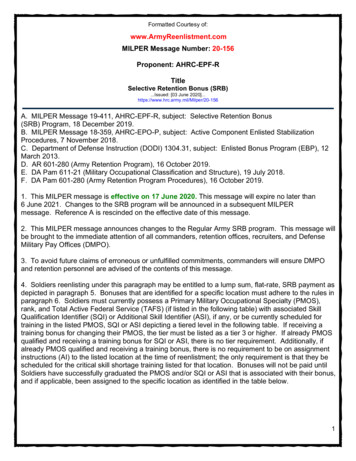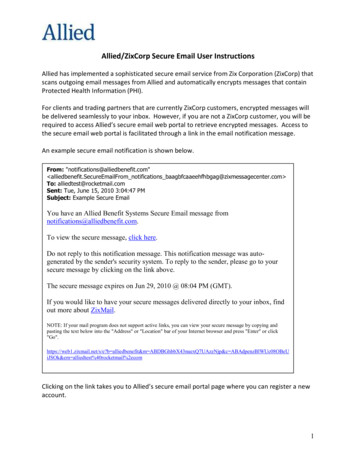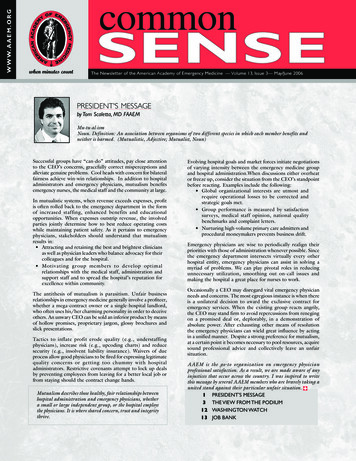
Transcription
W W W. A A E M . O R GThe Newsletter of the American Academgency Medicine — Volume 13y/June 2006AmericanAcademyy of EmerEmergency13,, Issue 3 — MaMay/JunePRESIDENT'S MESSAGEby Tom Scaletta, MD FAAEMMu·tu·al·ismNoun. Definition: An association between organisms of two different species in which each member benefits andneither is harmed. (Mutualistic, Adjective; Mutualist, Noun)Successful groups have “can-do” attitudes, pay close attentionto the CEO’s concerns, gracefully correct misperceptions andalleviate genuine problems. Cool heads with concern for bilateralfairness achieve win-win relationships. In addition to hospitaladministrators and emergency physicians, mutualism benefitsemergency nurses, the medical staff and the community at large.In mutualistic systems, when revenue exceeds expenses, profitis often rolled back to the emergency department in the formof increased staffing, enhanced benefits and educationalopportunities. When expenses outstrip revenue, the involvedparties jointly determine how to best reduce operating costswhile maintaining patient safety. As it pertains to emergencyphysicians, stakeholders should understand that mutualismresults in: Attracting and retaining the best and brightest cliniciansas well as physician leaders who balance advocacy for theircolleagues and for the hospital. Motivating group members to develop optimalrelationships with the medical staff, administration andsupport staff and to spread the hospital’s reputation forexcellence within community.The antithesis of mutualism is parasitism. Unfair businessrelationships in emergency medicine generally involve a profiteer,whether a mega-contract owner or a single-hospital landlord,who often uses his/her charming personality in order to deceiveothers. An unwary CEO can be sold an inferior product by meansof hollow promises, proprietary jargon, glossy brochures andslick presentations.Tactics to inflate profit erode quality (e.g., understaffingphysicians), increase risk (e.g., upcoding charts) and reducesecurity (e.g., insolvent liability insurance). Waivers of dueprocess allow good physicians to be fired for expressing legitimatequality concerns or getting too chummy with hospitaladministrators. Restrictive covenants attempt to lock up dealsby preventing employees from leaving for a better local job orfrom staying should the contract change hands.Mutualism describes those healthy, fair relationships betweenhospital administration and emergency physicians, whethera small or large independent group, or the hospital employsthe physicians. It is where shared concern, trust and integritythrive.Evolving hospital goals and market forces initiate negotiationsof varying intensity between the emergency medicine groupand hospital administration.When discussions either overheator freeze up, consider the situation from the CEO’s standpointbefore reacting. Examples include the following: Global organizational interests are utmost andrequire operational losses to be corrected andstrategic goals met. Group performance is measured by satisfactionsurveys, medical staff opinion, national qualitybenchmarks and complaint letters. Nurturing high-volume primary care admitters andprocedural moneymakers prevents business drift.Emergency physicians are wise to periodically realign theirpriorities with those of administration whenever possible. Sincethe emergency department intersects virtually every otherhospital entity, emergency physicians can assist in solving amyriad of problems. We can play pivotal roles in reducingunnecessary utilization, smoothing out on-call issues andmaking the hospital a great place for nurses to work.Occasionally a CEO may disregard vital emergency physicianneeds and concerns. The most egregious instance is when thereis a unilateral decision to award the exclusive contract foremergency services. When the existing group reacts angrily,the CEO may stand firm to avoid repercussions from renegingon a promised deal or, deplorably, in a demonstration ofabsolute power. After exhausting other means of resolutionthe emergency physicians can wield great influence by actingin a unified manner. Despite a strong preference for mutualism,at a certain point it becomes necessary to pool resources, acquiresound professional advice and collectively leave an unfairsituation.AAEM is the go-to organization on emergency physicianprofessional satisfaction. As a result, we are made aware of anyinjustices that occur across the country. I was inspired to writethis message by several AAEM members who are bravely taking aunited stand against their particular unfair situation.131213PRESIDENT'S MESSAGETHE VIEW FROM THE PODIUMWASHINGTON WATCHJOB BANK
EDITOR'S LETTEREDITOR’S LETTERCommon Senseby Howard Blumstein, MD FAAEMCommon Sense is the title of the famous pamphlet written in 1775,by Thomas Paine, explaining the rationale for Americanindependence from England. Forty-six pages long, it was perhapsthe most influential of all the early revolutionary literature. It hasbeen reported that 50 percent of the population had either readportions of it or had portions read to them. It was also reportedthat George Washington read it and was inspired by its contents,ordering that portions be read to his troops.If you look at it, make sure you read the very first paragraph of theintroduction. Here it is (there are several versions on the web, thetext is the same but the typeface and punctuation differ):PERHAPS the sentiments contained in the following pages, are notyet sufficiently fashionable to procure them general favor; a long habitof not thinking a thing wrong, gives it a superficial appearance ofbeing right, and raises at first a formidable outcry in defense [sic] ofcustom. But the tumult soon subsides. Time makes more converts thanreason.This is an exciting time to be part of AAEM. Our membershipgrows while other organizations within the house of medicinestruggle to maintain membership levels. The reason is simple: Moreand more emergency docs are rejecting those wrongs that inspiredour formation.When AAEM was first formed, there was a sense within the EMcommunity that we were somehow rebels doing far more damagethan good. Long discussions of our issues pulled in new membersslowly. That early negative reputation hurt us.But Paine was right. Time is our friend. Increasingly, AAEM is notseen as a disruptive and unnecessary force, but rather a professionalorganization with specific goals and an aggressive attitude.Increasingly, our colleagues are coming to see that the status quois unfair and unacceptable. More emergency docs are learning aboutOfficersTom Scaletta, MD, PresidentLarry Weiss, MD JD, Vice-PresidentHoward Blumstein, MD, Secretary-TreasurerJoseph Wood, MD JD, Immediate Past PresidentRobert McNamara, MD, Past Presidents Council Representativethe threats they face in their professional lives, some first hand.They are coming to realize just how important it is to have aprofessional society that can advocate for them.If AAEM were to disappear today, we would have left behind thislegacy: Emergency docs now understand that they need to protecttheir rights, and that they are entitled to work in fair conditions.It is no longer acceptable to allow contract holders, big and smallalike, to put us in a position in which they can push us around andtake big cuts of our income for very little service.AAEM has entered a new phase. With a legal fund available, wehave been able to pursue specific legal actions when appropriate.We can now get involved and offer our knowledge and experienceto embattled docs.Members have been inspired to take control of their professionallives, forming democratic groups or insisting that they be treatedfairly at work. They have championed the cause of legitimate boardcertification.I like to think that this newsletter has played a role in advancingthese ideas and empowering our members to stand up for theirrights, just as Thomas Paine’s original pamphlet did so many yearsago.****Having become Secretary-Treasurer (thank you, everyone, for yoursupport) and thus joining the executive committee, I have foundmyself overwhelmed. Accordingly, I have resigned as editor of thisnewsletter. David Kramer, MD FAAEM, at York Hospital inPennsylvania, is taking over. I am sure that his leadership and ideaswill overshadow my tenure in this position.Keep those letters and articles coming, folks. It is through theexchange of ideas that we all become enriched.Board MembersTracy Boykin, MDAnthony DeMond, MDStephen Hayden, MDDavid Kramer, MDJames Li, MDKevin Rodgers, MDRichard Shih, MDAndy Walker, MDAssociate Board MemberMark Reiter, MD MBAAAEM/RSA President 2006-2007Brian Potts, MD MBACommon Sense StaffHoward Blumstein, MD EditorHelen Kopec, Managing EditorMiko Walker, Job Bank CoordinatorKat Peterson, Art DirectorArticles appearing in Common Sense are intended for the individual use of AAEM members. They may not be duplicated or distributed without the explicit permission of AAEM. Permissionis granted in some instances in the interest of public education. Requests for reprints should be directed to Helen Kopec, Managing Editor, at: AAEM, 555 East Wells Street, Suite 1100,Milwaukee, WI 53202, Tel: (800) 884-2236, Fax: (414) 276-3349, Email: hkopec@aaem.org.AAEM Mission StatementThe American Academy of Emergency Medicine (AAEM) is the specialty society of emergency medicine. AAEM is a democratic organization committed to the following principles:1. Every individual should have unencumbered access to quality emergency care provided by a specialist in emergency medicine.2. The practice of emergency medicine is best conducted by a specialist in emergency medicine.3. A specialist in emergency medicine is a physician who has achieved, through personal dedication and sacrifice, certification by either the American Board of Emergency Medicine (ABEM) or theAmerican Osteopathic Board of Emergency Medicine (AOBEM).4. The personal and professional welfare of the individual specialist in emergency medicine is a primary concern to the AAEM.5. The Academy supports fair and equitable practice environments necessary to allow the specialist in emergency medicine to deliver the highest quality of patient care. Such an environmentincludes provisions for due process and the absence of restrictive covenants.6. The Academy supports residency programs and graduate medical education, which are essential to the continued enrichment of emergency medicine, and to ensure a high quality of care for thepatient.7. The Academy is committed to providing affordable high quality continuing medical education in emergency medicine for its members.Membership Information* Associate Member: 250 (Non-voting status)Fellow and Full Voting Member: 345 (Must be ABEM or AOBEM certified in EM or Pediatric EM)AAEM/RSA Member: 50 (Non-voting status)Emeritus Member: 250 (Must be 65 years old and a full voting member in good standing for 3 years)Student Member: 50 (Non-voting status)International Member: 125* Associate membership is limited to graduates of an ACGME or AOA approved Emergency Medicine program.Send check or money order to: AAEM, 555 East Wells Street, Suite 1100, Milwaukee, WI 53202, Tel: (800) 884-2236, Fax: (414) 276-3349, Email: info@aaem.orgAAEM is a non-profit, professional organization. Our mailing list is private.2
by Kevin Rodgers, MD FAAEMI am very happy to say that my predictioncame true. The Academy’s 12 th AnnualScientific Assembly was a tremendous success!Nearly 600 board certified emergency physicians attended ourmost recent session in San Antonio. I am confident that everyonewent home as better practitioners because of the excellentpresentations that covered ever ything from ef fectivecommunication skills, to disaster planning and pediatric conscioussedation.We were incredibly fortunate to have the Surgeon General, ViceAdmiral Richard Carmona, deliver the keynote address, whichwas both informative and humorous. The pre and post conferencecourses were well received including two new presentations, theEMS Medical Director course and the Trauma Resuscitation forthe Community Doc course. It is worth mentioning that one ofthe top rated speakers was Jonathan Davis, a “graduate” fromour Open Mic presentations from the 2005 Assembly. Finally,congratulations to Mike Lambert for the Educator of the YearAward, Michelle Lin for the Young Educator Award and to AmalMattu who was named the RSA Program Director of the Year.It is apparent, based on evaluations, that each speaker put anincredible amount of energy into developing and presenting theirindividual sessions. Once again I believe we owe a tremendousdebt of gratitude to Joe Lex and Ghazala Sharieff for their efforts.I would also like to thank the AAEM staff (Kay, Janet, Helen,Tom, Miko and Kate) for their tireless efforts in making ourconference the premier educational event for board-certifiedemergency physicians.I would like to take a moment to discuss a “hot topic.” Many ofyou have closely followed the debate surrounding the use ofpharmaceutical industry support to fund the Scientific Assembly(SCIASS). Three hundred eleven members (18% of our votingmembers) responded to the on-line survey that AAEM conducted.This is clearly a controversial topic that ultimately splits physiciansinto two camps, the pros and the cons. It is a difficult topic forme personally depending on which “hat” I am wearing. As aprogram director (and in my own personal viewpoint) I believethat the pharmaceutical industry should not fund, nor providespeakers for any educational event involving physicians due to theirundue influence on prescribing practices which affect our patients.As “draconian” as that may appear, the three major nationalorganizations that govern medical education, the AccreditationCouncil for Graduate Medical Education (ACGME), theAssociation of American Medical Colleges (AAMC) and theAccreditation Council for Continuing Medical Education(ACCME) have all recently written policy statements thatsignificantly restrict the involvement of the pharmaceutical industryin medical education.AAEM ACTIVITIESTHE VIEW FROM THE PODIUMHowever, when I put on my Board of Directors “hat,” I hearmany pro voices among my constituents. Indeed, looking at theresults of the survey, a majority of our members (79%) were againstprohibiting industry support but believed that pharmaceuticalfunding should be restricted (62%). Results were relatively splitwhen members were asked if they would be willing to pay additionaldues or a registration fee ( 100-400) to support the SCIASS ifindustry support was abolished. Impassioned individual commentsvoiced every imaginable pro and con argument and spanned sixsingle-spaced pages. Controversial indeed!There are many questions and no perfect solution. What doesrestrict mean? How can we maximize the use of AAEM’s funds? Isthere a difference between funding from the pharmaceuticalindustry versus medical equipment/administrative supportcompanies? Are unrestricted education grants acceptable? In orderto answer these questions, Tom Scaletta has appointed a task forceto formulate a policy which governs industry support.The Education Committee now focuses on making the 13th AnnualScientific Assembly even better, a difficult challenge consideringthe multitude of distractions that Las Vegas offers! We areconsidering several new presentations including the first iterationof the AAEM Resuscitation Course. Do not hesitate to share withme (krodgers@clarian.org) any topics, speakers, or innovationsthat you feel would contribute to the excellent quality of ourScientific Assembly.THE AMERICAN ACADEMY OFEMERGENCY MEDICINE PRESENTS THEPEARLS OF WISDOMORAL BOARD REVIEW COURSESeptember 9 – 10, 2006PhiladelphiaOrlandoChicagoLos AngelesRegistration Opens June 5, 2006Designed to meet the educational needs of Emergency Medicinepractitioners preparing to take the ABEM or theAOBEM oral board examinationFor More Information: www.aaem.org3
AAEM ACTIVITIESUpcoming AAEM-Endorsed or AAEMAAEM-EndorsedSponsored Conferences fforor 2006Conferences2006May 24-26, 2006 High Risk Emergency MedicineHotel Nikko, San Francisco, CAConference sponsored by San Francisco General Hospitaland the Department of Emergency Medicine at theUniversity of California, San .aspx?coursenumber MDM06Q23May 31, 2006 The 3rd Annual New York Symposium on InternationalEmergency MedicineSchwartz Auditorium, New York UniversitySchool of Medicine, New York, NY.Co-Sponsored by North Shore-LIJ, NYU-Bellevue andACEP International Section.http://www.iems-2006.comJune 11-14, 2006 2nd World Congress on Ultrasound in Emergency andCritical Care MedicineJavits Center, New York City, NYOrganized by New York Methodist Hospital in New York(New York Presbyterian Healthcare), Niguarda Ca’GrandaHospital in Milan, and Avicenne Hospital in Bobigny in Paris.http://www.wcu2006.com/September 9-10, 2006 AAEM Pearls of Wisdom Oral Board Review Coursein Chicago, Los Angeles, Orlando, PhiladelphiaCourse sponsored and organized by the AmericanAcademy of Emergency Medicinehttp://www.aaem.orgOctober 2006 (dates to be determined) AAEM Written Board Review CourseHilton Newark Airport Hotel, Newark, New JerseySponsored and organized by the American Academy ofEmergency Medicinehttp://www.aaem.org Second International Emergency Medicine and DisasterPreparedness ConferenceAshok Hotel, New Delhi, IndiaCo-sponsored by North Shore-Long Island Jewish HealthSystem and the American College of EmergencyPhysiciansJointly Sponsored with the Society of EmergencyMedicine, India and the American Academy for EmergencyMedicine in IndiaHosted by Fortis Hospitalwww.intem2006.comDecember 3-8, 2006 Maui 2006: Current Concepts in Emergency CareWailea Marriott, Wailea, HawaiiSponsored by the Institute for Emergency MedicalEducation and the Washington Chapter of the AmericanCollege of Emergency Physicianswww.ieme.comMarch 12-14, 2007 AAEM 13th Annual Scientific AssemblyCaesar’s Palace, Las Vegas, NevadaSponsored by the American Academy ofEmergency MedicineFREE Registration for AAEM Membershttp://www.aaem.orgDo you have an upcoming educational conference oractivity you would like listed in Common Sense and on theAAEM website? Please contact Tom Derenne to learnmore about the AAEM endorsement approval process:tderenne@aaem.org.All endorsed, supported and sponsored conferences andactivities must be approved by AAEM’s ACCMESubcommittee.November 17-19, 2006Associate Editor Position Available for the Journal of Emergency MedicineApplications are now being accepted for the position of Associate Editor for the Journal of Emergency Medicine. Inconjunction with the Editor-in-Chief, the American Academy of Emergency Medicine announces a national search toappoint a new Associate Editor. Associate Editors for JEM have the responsibility for collating reviews of submittedmanuscripts, recommending initial acceptance, revision, or rejection decisions, performing secondary reviews of revisedmanuscripts, as well as assisting the Editor-in-Chief in assigned journal operations. Interested individuals should haveextensive experience in editing, research and critical appraisal, and manuscript review. Applicants must be board certifiedin emergency medicine, members of AAEM, and affiliation with an academic emergency medicine program is preferred.Please forward a cover letter and CV to the AAEM Education Committee at the address below. The deadline for receiptof applications is June 1, 2006.AAEM Education CommitteeAttn. Kay Whalen555 East Wells Street, Suite 1100, Milwaukee, WI 53202-3823Tel: (800) 884-2236 - Fax: (414) 276-33494
RCOMMON SENSE RAAEM Resident & StudentAssociationResident Recap: San Antonio and the 12th Annual AAEM Scientific Assemblyby Brian Potts, MD MBAPresident, AAEM/RSAResidents and students in San Antonio on February 16-18, 2006,enjoyed many educational, political and social activities. TheScientific Assembly provided a perfect mix of high quality lecturesand opportunities to meet some of the major players in emergencymedicine. A recap of these events follows:Thursday (Day 1)The opening of the Assembly at the Marriott Rivercenter featuredkeynote speaker, US Surgeon General Vice Admiral RichardCarmona. Dr. Carmona has worked in various positions in themedical field including paramedic, registered nurse and physician.He spoke about his upbringing, important events that led himinto the medical field, his current role with the government andvital issues facing the U.S. and the health care field in 2005.Following this talk, noted medical author Dr. Abraham Verghesegave the second keynote lecture. Dr. Verghese is the Director ofthe Center for Medical Humanities and Ethics at the Universityof Texas Health Science Center in San Antonio. Lecturesthroughout the rest of the day included talks by the always popular,Amal Mattu, Edward Panacek, Peter DeBlieux, Col. Lee Cancio,William Mallon and Larry Weiss.On Thursday afternoon, Peter Rosen moderated the AAEM JEMResident & Student Research Forum. Selected from a field ofimpressive resident and student presenters, first place was awardedto Gil Shlamovitz at UCLA for his original research, “BlindUrethral Catheterization in Trauma Patients Suffering from LowerUrinary Track Injuries.” Second and third places were awarded toChristopher Fischer and Johnny Dias, respectively, for their fineresearch presentations.During the AAEM/RSA Board meeting in the late afternoon, theBoard reviewed progress on many initiatives and projects. Ourplanned budget for next year and current financial standing wasaddressed after our first year with an independent budget. TheYoung Physician Section Taskforce presented their proposal for anew AAEM section, and the Board agreed to support furtherdevelopment of this new group. The chairs of the Communication,Education, Membership and Advocacy Committees updated theboard on their progress to date.Following the Awards Presentation and Opening Reception, theevening was filled with social events. The AAEM FoundationDinner helped raise money for AAEM sponsored-initiatives. Manymembers supported the event and enjoyed cocktails and dinner atSunset Station. Later that evening, AAEM/RSA held their annualresident party at Pat O’Briens. More than 150 people attendedthe function sponsored by California Emergency Physicians,enjoying good company, drinks and good music.Friday (Day 2)Friday morning began with a keynote presentation by best-sellingauthor Mark Victor Hansen.Best known for his publicationsfocused on helping people and organizations reshape their personalvision of what is possible, his “Chicken Soup for the Soul” bookssold more than 100 million copies around the world. Lecturesthroughout the rest of the day included talks by Peter Rosen, BobMcNamara, Joe Lex, Jeffrey Kline, Chris Fox, David Karras andRichard Harrigan. AAEM again featured the Open Mic Sessionswhich gave new speakers and residents the opportunity to lectureand present to a national audience.6On Friday evening, 100 conference attendees and guests enjoyedthe 57th Annual San Antonio Stock Show & Rodeo at the SBCCenter. Rodeo-goers delighted in a night of Barrel Racing, SteerWrestling, Bareback Riding and Bull Riding; but the crowd favoriteand my personal favorite entertainment was the Mutton Bustin’event. Children between the ages of 4-7 years-old were placed onsheep and instructed to hold on. Off they went out of the gate onsurprisingly fast moving sheep. Hilarious! Overall, the rodeo was aunique event which highlighted the culture and diversity in theAssembly’s host city.Saturday (Day 3)The Resident Track, planned by the AAEM/RSA EducationCommittee, began on Saturday morning. Dr. Robert McNamaralectured on “Top Problems Facing AAEM Today.” This lecturehighlighted important themes demonstrating the value of AAEM’ssupport of the individual EM physician and democratic physiciangroups. Dr. Robert Simon gave a talk on “Procedures: Tips andTricks,” which covered different kinds of laceration repairs usingplastics techniques that an emergency physician can utilize.Following this presentation, Dr. Larry Weiss and Dr. Joe Woodreviewed medical malpractice lawsuits. They covered what everyresident should know if you are involved in a lawsuit as a practicingEM physician. They went through the processes and gave tips onmanaging yourself successfully in this very stressful situation. Theresident track closed with a fun game of “Jeopardy” pitting residentsagainst a panel of attending faculty. The attendings pulled off thewin in a resounding fashion, but I question whether the game wasrigged in their favor. Our own Alex Trabek (aka Gerald Maloney)verified to me that the game was fair. Our resident panel will needto start training for next year’s rematch to make up for this loss.To close out the resident activities at the Assembly, Dr. Amal Mattuand Dr. Kevin Rodgers taught the highly regarded post-conferencecourse, “Preparing for In-service: What to Expect on Your Test.”This course served as a four-hour intense review of many of thehigh-yield topics that often appear on the yearly In-service Exam.They have successfully organized this course for years, and residentscome away with a great insight into what they should expect whenthey take the exam. Many residents gave the course high marks forthe quality of the lectures and topics covered. Furthermore, thetiming of the course was perfect since the In-service Exam wasadministered four days later on February 22, 2006, for all residentsin the country. Personally, I have attended the review course twiceand feel that this is the best four hours you could possibly spendduring final preparation for the exam.Also on Saturday afternoon, AAEM sponsored the first-ever StudentSection Track which featured Ken Iserson, author of the popularbook, “Getting into a Residency: A Guide for Medical Students,”and James Tysinger. They lectured to a packed room of medicalstudents interested in learning steps to help them navigate the paththrough medical school, the application process and matching inemergency medicine. (For more on this course please see WarrenWiechmann’s article on pg 8).Well, that’s all folks! Stay tuned for the 13th Annual ScientificAssembly at Caesars Palace in Las Vegas. Mark the dates March12-14, 2007, in your calendar and plan to attend. Send an email tome at bpotts@uci.edu if you would like to give AAEM/RSAsuggestions or provide ideas for lectures, events, etc. for next year’sScientific Assembly.
AAEM Resident & StudentAssociationR COMMON SENSERZen and the Art of the Fourth Year Scheduleby Nicholas Genes, MD PhDIt’s that time of year again — externships! All the planning, phonecalls and emails all the nail-biting, new experiences andopportunities the endless forms and bureaucracy When youthink about it, it’s a good warm-up for the match, and maybe lifein general. So approach it with some smarts and some sage advicefrom those who’ve done it.When my editor approached me to write about fourth-yearcurriculum planning, I was pleased. She probably figured that asan intern, I had the right perspective to be advising third-years – aveteran of the match process, but not so removed from theambitions and fears of today’s students. Perhaps she had heard ofthe arrangements I had made regarding externships, which gaveme plenty of exposure to various programs of interest, while lettingme take advantage of all the opportunities that fourth year provides.“No,” she explained. “It’s just that everyone else already has theirassignments.”Alas, it’s fortunate I had a fourth year worth writing about. I learneda lot, had some great experiences, saw many EM programs, andenjoyed interviews spaced out in a not-too-hectic schedule. ByFebruary, I was able to generate my rank list with confidence. Hereis my advice:Have a plan, but be flexible. Develop your concept of what yourideal fourth year looks like as you’re preparing for your school’scurriculum lottery. After you get your lottery results, keep this planin mind as you start trading and making inquiries at otherinstitutions. You might get stymied, but that’s ok. Somebureaucracies are intractable; some requirements can’t be avoidedor put off. Also, you might change your mind about your planlater on in the year – that’s ok, too. There’s enough time andplasticity in fourth year to maneuver around obstacles, takeadvantage of new opportunities that present themselves, and stillwind up with a convenient schedule and great education. Just keepyour eyes open and take the initiative.Put your emergency months up front, with your homeinstitution before an away rotation in EM. Away rotations aretricky enough with new living accommodations, different hospitalsand computer systems and faculty. It is a little easier handling itwhen you’ve already spent a month learning the basics of how anED runs. “Oh,” you say, in a high-pitched whiny voice that shouldnever be heard by people who evaluate you, “but there are 15students in my school who want to do EM in July and only eightspots!” It’s ok. You can rotate at your home institution later in theyear if you need to. Programs understand this, and are actuallyquite good at adjusting expectations. (You will not be expected todiagnose organophosphate poisoning and perform a retrogradeintubation while simultaneously running a code in the next roomon your first, or even your second, day.)Choose an away EM rotation in a program you think you’dlike to match into, in a city you think you’d like to live. Consultwith your spouse and family about this. If they are allergic to thecold weather places for instance, now is the time to find out. Askyour school’s EM advisors about this too. EM is still a relativelysmall, well-connected world, and your advisors can often tell youthe strengths and weaknesses of programs and whether you wouldbe a good fit.Finally, have a heart-to-heart talk
WWW.AAEM.ORG The Newsletter of the American Academy of Emergency Medicine —Volume 13,,, Issue Issue Issue 3— May/June 2006 1 PRESIDENT'S MESSAGE 3 THE VIEW FROM THE PODIUM 12 WASHINGTON WATCH 13 JOB BANK PRESIDENT'S MESSAGE by Tom Scaletta, MD FAAEM Successful groups have "can-do" attitudes, pay close attention to the CEO's concerns, gracefully correct misperceptions and
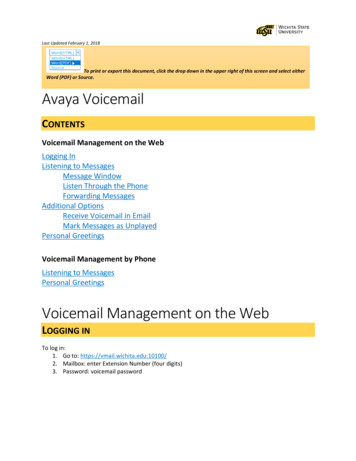
![WELCOME [ montclair.edu]](/img/31/commencement-program-2022.jpg)
